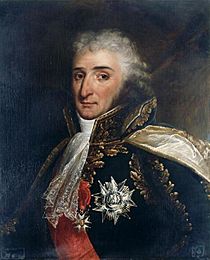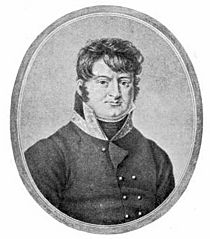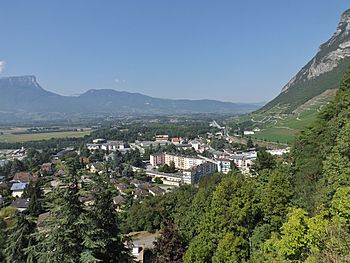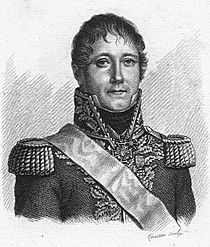Battle of Saint-Julien (1814) facts for kids
Quick facts for kids Battle of Saint-Julien (1814) |
|||||||
|---|---|---|---|---|---|---|---|
| Part of the Campaign of France of the Sixth Coalition | |||||||
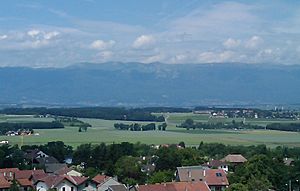 The Jura Mountains can be seen from Saint-Julien. |
|||||||
|
|||||||
| Belligerents | |||||||
| Commanders and leaders | |||||||
| Strength | |||||||
| 4,800–11,000 13 guns |
5,600–6,000 29 guns |
||||||
| Casualties and losses | |||||||
| 1,300 killed, wounded, or captured 5 guns lost |
650 killed, wounded, or captured | ||||||
The Battle of Saint-Julien happened on March 1, 1814. It was a fight between French troops and Austrian soldiers. The French were led by Jean Gabriel Marchand, and the Austrians by Johann Nepomuk von Klebelsberg. Even though the French attacked hard, the Austrians managed to hold their ground.
This battle was part of a bigger conflict called the War of the Sixth Coalition. The next day, the Austrian forces moved back to the city of Geneva, which was about 9 kilometers (5.6 miles) away. This battle was part of a larger plan where French Marshal Pierre Augereau fought against Austrian forces led by Ferdinand, Graf Bubna von Littitz.
In 1814, Emperor Napoleon was fighting against the main Allied armies. These armies were led by Karl Philipp, Prince of Schwarzenberg and Gebhard Leberecht von Blücher. Their battles happened east of Paris. At the same time, another part of the war was happening around Lyon and Geneva in the south.
In January 1814, the Austrians took control of Geneva. They also moved into a large part of eastern France. However, they couldn't capture Lyon. In mid-February, Marshal Augereau started an attack from Lyon. He wanted to take back the land to the north. On his far right side, Marchand's troops took back parts of Savoie. They even reached the edges of Geneva, which was a very important Austrian base. This made Schwarzenberg worried about his supply lines. He quickly sent many soldiers to protect his southern side.
Contents
The Invasion Begins
Geneva Falls to the Austrians
Instead of going straight into France from the east, the Austrian Army of Bohemia went south into Switzerland. On December 21, 1813, Austrian troops crossed the Rhine River. They crossed at places like Basel and Schaffhausen. Swiss soldiers did not try to stop them. After crossing the Rhine, the Austrian army turned right. They marched through Switzerland and into France.
One of the groups in this army was Ferdinand, Graf Bubna von Littitz's division. It had about 6,388 soldiers and 24 cannons. There were also other large groups of soldiers. When Bubna reached Geneva on December 30, 1813, the French commander there had a sudden illness. His 1,500 soldiers quickly surrendered to the Austrians. Geneva had many weapons, including 117 large cannons.
Napoleon was very angry about losing Geneva. He even put the city's leader in prison, even though he was later found innocent. After taking Geneva, Bubna acted almost like an independent commander. He left Theophil Joseph von Zechmeister in charge of Geneva. Bubna then captured Bourg-en-Bresse on January 11, 1814. Napoleon ordered Marshal Pierre Augereau to defend Lyon. He also wanted Augereau to threaten the Allied forces and take back Geneva.
Lyon is Saved
Augereau arrived in Lyon on January 14. He learned that there were only 1,200 soldiers and 500 new recruits to defend the city. Augereau left Louis François Félix Musnier to do his best. He then went to Valence to find more troops. By January 16, Austrian patrols were outside Lyon's walls. Musnier thought his soldiers couldn't hold the city. So, on January 17, he moved them to the west side of the Saône River. This meant the city was empty.
When Bubna found out, he sent an officer to demand Lyon's surrender. But when the Austrian officer arrived, a crowd gathered. They started threatening to throw him in the river. Musnier pretended his forces were much stronger. He also made it seem like the city's people were very angry. The Austrian officer's report made Bubna change his mind. He decided not to try to take the city right away. Musnier then moved his troops back into Lyon.
Bubna stayed near Lyon on January 18 and 19. Late on the 19th, 1,200 French soldiers arrived from Valence. They helped push the Austrians out of the city's outer areas. On February 20, more troops and cannons arrived in Lyon. On the 21st, Augereau returned with 200 cavalry. By this time, Bubna's group had gone north to Pont-d'Ain. He soon left Mâcon as well. Bubna missed a great chance to capture Lyon.
During this time, Zechmeister invaded Savoie. He took Aix-les-Bains and Chambéry. The Austrian II Corps started blocking Besançon on January 11. Most of the Austrian army kept moving northwest. They captured Langres on the 17th. Other battles, like the First Battle of Bar-sur-Aube, also happened around this time.
The French Fight Back
France Recovers Some Land
Jean Gabriel Marchand was put in charge of defending Savoie. Joseph Marie, Count Dessaix was his second-in-command. On January 25, 400 French soldiers with two cannons successfully defended a bridge. This bridge was over the Isère River at Montmélian. On January 31, Zechmeister's Austrians were stopped. They attacked Fort Barreaux, where even 10-12 year old boys helped by carrying ammunition.
There was a small fight at Chapareillan on February 6. Local people, including National Guards, old soldiers, hunters, and customs officers, helped defend the area. Farther west, Bubna took Chalon-sur-Saône easily. He also captured Mâcon on February 8.
By February 1814, Augereau had enough new soldiers to organize them into four main groups. He had about 4,200 experienced soldiers, 5,500 veterans, 3,500 new recruits, and 4,800 more recruits. He also had 2,000 French cavalry. Augereau decided to attack Bubna's army, which now had fewer soldiers, about 12,000 men.
Augereau ordered two of his groups to move northeast from Lyon towards Geneva. They were supposed to meet Marchand's group outside the city. The attack started on February 17. Augereau stayed in Lyon to give orders. His troops moved north and captured Villefranche-sur-Saône on February 18. They took Mâcon the next day. They pushed 3,000 Austrians back and captured 300 prisoners.
Another French group moved northeast. They pushed 1,000 Austrian soldiers and 300 cavalry out of Meximieux on the 18th. After taking Nantua on February 19, they chased the Austrians north. Augereau sent thousands of reserve troops to help. When the Austrian commander Klopstein joined Bubna, Bubna decided to leave Bourg-en-Bresse on February 20.
On February 18, 1814, Napoleon won a big victory at the Battle of Montereau. The next day, Schwarzenberg decided to retreat. He planned to meet another Allied general and fight Napoleon. However, on the evening of the 20th, he got bad news. He heard that Augereau and Marchand were moving forward in the south. Schwarzenberg quickly sent a large group of soldiers to Dijon. On February 23, the Austrian field marshal continued his retreat.
The Austrian field marshal was worried. He had received a letter from Emperor Francis I of Austria. The emperor wrote that the enemy could attack their left side from the South of France. He said it was important to protect the retreat route. Napoleon wanted Augereau to move towards Chalon-sur-Saône. He wanted Augereau to create the threat that Francis feared. On February 21, Napoleon sent Augereau a letter. He told the marshal to be aggressive. Napoleon wrote that Bubna had only about 10,000 weak soldiers. He said they would disappear like fog.
Marchand's Advance
On February 15, Marchand sent 800 soldiers to attack the important Echelles Pass. While light infantry rushed the barricade, other soldiers attacked positions on the sides. With the pass secured, Marchand's group marched through the next day. They were headed for Chambéry. Also on February 16, Dessaix with 1,400 soldiers pushed an Austrian group out of Montmélian. He then joined Marchand.
Johann Nepomuk von Klebelsberg gathered the Austrians at Chambéry. But on February 19, he had to retreat after being surrounded. In January, Klebelsberg had commanded a cavalry division. The Austrians took a position south of Aix-les-Bains. Their right side was on the Lake of Bourget. They had 800 cavalry and 2,200–3,000 infantry. On February 22, the French pushed Klebelsberg out of these defenses. They used a brilliant cavalry charge.
Napoleon was not happy with Augereau's actions. He wrote that Augereau was spreading his forces out too much. He wanted the marshal to gather his army into one strong force. He wanted Augereau to lead them himself. As the French attack paused, Bubna quickly moved his troops around. He ordered one brigade to hold Chalon-sur-Saône. He sent another brigade to help defend Geneva.
On February 24, Marchand's main group left Aix-les-Bains. They pushed an Austrian force out of Albens, where the road splits. Moving up the right road the next day, Marchand caused Zechmeister to leave Annecy. He chased him north to Allonzier-la-Caille. Also on February 25, Klopstein's brigade reached Frangy. This formed Klebelberg's western side. Marchand advanced up the left road. He captured Rumilly and Hauteville-sur-Fier. He then occupied Frangy on February 27.
The Battle of Saint-Julien
Klebelsberg had 5,600 soldiers and 29 cannons. Bubna had promised him more soldiers through Switzerland. So, Klebelsberg set up his defenses. He placed Zechmeister on his left side at Archamps. He put Klopstein on his right side at Saint-Julien-en-Genevois and Bardonnex. Marchand ordered Serrant to move behind Mont Salève to go around Zechmeister. The French general sent Dessaix to attack Klopstein's right side. This attack was aimed at the small villages of Tairier (Thairy) and Turens (Thérens). Marchand himself would lead the main attack directly against Saint-Julien.
On March 1, 1814, at 8:00 am, Serrant started pushing back the Austrian soldiers. They were pushed from Le Petit Châble into their main defense line near Archamps. Two hours later, Dessaix's group, in three columns, drove the Austrians from Viry, Présilly, and Songy. A small group of Austrian soldiers held up the French advance. But they were surrounded by one of Dessaix's columns moving from Songy.
Dessaix wanted to go around the Austrian right side. He ordered a group of soldiers to move along the Aire stream. To stop this, the Austrians moved some soldiers to their right side. Still, Dessaix captured Crache and Tairier. He also took some high ground nearby. Marchand's central group reached the hills south of Saint-Julien. They began to attack the town. This attack was stopped by three companies of Austrian soldiers.
Marchand launched a second attack. But it was pushed back by an Austrian counterattack. After this success, the Austrians took back Tairier. Dessaix sent more soldiers into the fight. But his attempts to break the Austrian right side were stopped by five companies of Austrian soldiers. By nightfall, Dessaix held Tairier. He also had troops moving along the Turnes ravine.
Marchand ordered another attack against Saint-Julien. But his group met a battery of 14 Austrian cannons. These included four powerful 12-pound cannons. The Austrian cannons were better than the French ones. They knocked out two or three of the French cannons. Both sides stayed on the battlefield for the night. Marchand was worried because his troops had used almost all their ammunition. He thought he might have to retreat about 100 kilometers (62 miles) to Fort Barraux to get more supplies.
What Happened Next
The Battle of Saint-Julien was a win for the Austrians. They caused about 1,200 to 1,400 French casualties. Meanwhile, the Austrians only lost about 650 soldiers. Another report says the French lost 1,000 killed and wounded, and 300 captured. They also lost five cannons.
Meanwhile, Augereau had sent another group of soldiers to join Marchand. This group captured Fort l'Écluse. They then moved along the north side of the Rhône River towards Geneva. Bubna was worried about this new threat. He quickly ordered Klebelsberg to pull back from Saint-Julien to Geneva. Marchand was able to get ammunition from Fort l'Écluse.
In late February, another French group occupied Lons-le-Saulnier. They chased the Austrians to Poligny. Augereau set up his headquarters in Lons-le-Saulnier. He planned to move east through Morez to Nyon on the shore of Lake Geneva. By March 2, his leading soldiers were in Morez in the Jura Mountains.
When Bubna heard that Augereau's group reached Saint-Cergue near Nyon, he knew he had to act. He either had to prepare for a siege in Geneva or fight outside the city. He sent his cavalry far back to Yverdon-les-Bains. Another French group occupied Saint-Genis-Pouilly on the west side of Geneva. Marchand held the south bank of the Arve River.
Augereau mistakenly thought Marchand could easily capture Geneva. So, he called back one of his divisions. He gathered his main groups and prepared to march northeast to Besançon. He planned to defeat another Austrian group there. When Bubna heard about this change in French plans, he stayed in Geneva. He knew Marchand didn't have enough soldiers to capture the city alone.
A large Austrian army of 40,000 soldiers arrived on March 4. They came to Chalon-sur-Saône. Other Austrian groups attacked Poligny and occupied Dole. Augereau gave up all his gains. He quickly retreated to Lyon to protect that city.
Who Fought in the Battle
Here are some details about the armies that fought in the Battle of Saint-Julien.
Austrian Army: March 1, 1814
The main Austrian commander was Ferdinand, Graf Bubna von Littitz.
- His division included:
- A brigade led by General Theophil Joseph von Zechmeister. This had a Jager Battalion, a Grenz Infantry Regiment, and Hussar cavalry. They also had six cannons.
- A brigade led by General Joseph Klopstein von Ennsbruck. This had two Infantry Regiments and eight cannons.
- Another division was led by General Johann Nepomuk von Klebelsberg. This included a Grenz Infantry Regiment, Dragoon cavalry, and six cannons.
- The Geneva city defense had three infantry battalions, cavalry, and cannons.
- There was also a reserve artillery unit with six 12-pound cannons.
French Army: February 15–16, 1814
The main French commander was General Jean Gabriel Marchand.
- His forces included:
- A brigade led by General Joseph Serrant. This group had about 5,206 soldiers from various Light and Line Infantry Regiments. They also had Customs Guards and some cavalry.
- Another division was led by General Martial Bardet. This group had about 4,325 soldiers from different Light and Line Infantry Regiments. This division arrived on March 2.


